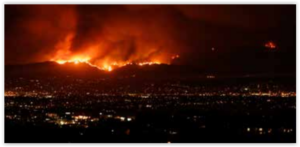Feeling the Heat
WHEN WILDFIRES THREATEN INDOOR AIR QUALITY
No, you’re not imagining things. It really is getting hotter out there.
 There’s been an increase in the number of Texas wildfires over the last few years. Last year, there were over 900 wildfires in the state of Texas alone. Rising temperatures and droughts will likely only make these blazes worse. The biggest threats these fires pose is the loss of human life and immense property damage. However, even if you or your building are far enough away from the flames, wildfires can still cause lasting damage.
There’s been an increase in the number of Texas wildfires over the last few years. Last year, there were over 900 wildfires in the state of Texas alone. Rising temperatures and droughts will likely only make these blazes worse. The biggest threats these fires pose is the loss of human life and immense property damage. However, even if you or your building are far enough away from the flames, wildfires can still cause lasting damage.
Soot and carbon contamination in the indoor air and on surfaces inside buildings are a real and often overlooked problem after wildfires burn through. This contamination can get inside buildings thanks to smoke, which can travel great distances very quickly. Smoke that gets caught in the high atmosphere can even travel thousands of miles before gravity pulls the particles back down. Last summer, smoke from the California wildfires reached New York City, over 3,000 miles away. Keep in mind that smoke can linger well after a fire is put out, which means smoke can get inside your building for days after the wildfire has been extinguished.
Due to the size of smoke and soot particles — which can be less than 2.5 picometers in diameter — simply closing the door and windows won’t keep them out of your building. Many commercial buildings draw air from the outside, and the ultra-fine articles of smoke and soot are too small to be removed by standard air filters. Buildings with HEPA filters aren’t automatically safe, either. Building occupants can bring in ash and soot particles on their clothing and through foot traffic.
When smoke particles enter an indoor environment, they can threaten the health of people in that environment. When breathed in, these particles can penetrate the lungs and may lead to coronary heart disease, asthma, bronchitis, or other respiratory illnesses. Soot exposure can also irritate a person’s skin. Depending on the nature of the fire, it is possible that soot may also contain certain metals or chemicals that may pose a health risk.
Soot can also damage property if left unchecked. The fine particles can easily stain carpets, drapes, and other items throughout a building. Additionally, the sharp odor from smoke may permeate furniture and walls, lingering for years. These effects are not just aesthetically unpleasant; they can trigger health problems in building occupants down the road.
If your building has been exposed to smoke and soot, whether due to distant wildfires, a nearby residential fire, or a fire within your own building, it is crucial to respond appropriately. It’s not enough to assign the janitorial crew to scrub black soot stains off the wall and call it a day. If you suspect your building may be suffering from soot and carbon contamination, contact a fire restoration company with experience in cleaning commercial buildings and perform follow-up tests on the IAQ to make sure the job was done right.
Texas wildfire season will soon reach its peak. Make sure your building is protected from all the damage those flames can do.
